Table of Contents
Karnataka Traditional Dance: Karnataka, a prominent Indian state and a land of diverse traditions and culture, has played a substantial role in shaping Indian culture. Its influence has left a lasting imprint on the cultural tapestry of India. Among its many cultural contributions, Karnataka has given birth to several renowned dance forms that continue to captivate audiences worldwide. Karnataka boasts a diverse and vibrant tradition of arts, including folk dances and puppetry, among others. In this blog, let’s explore seven of the most celebrated dance forms that have emerged from Karnataka’s rich cultural heritage.
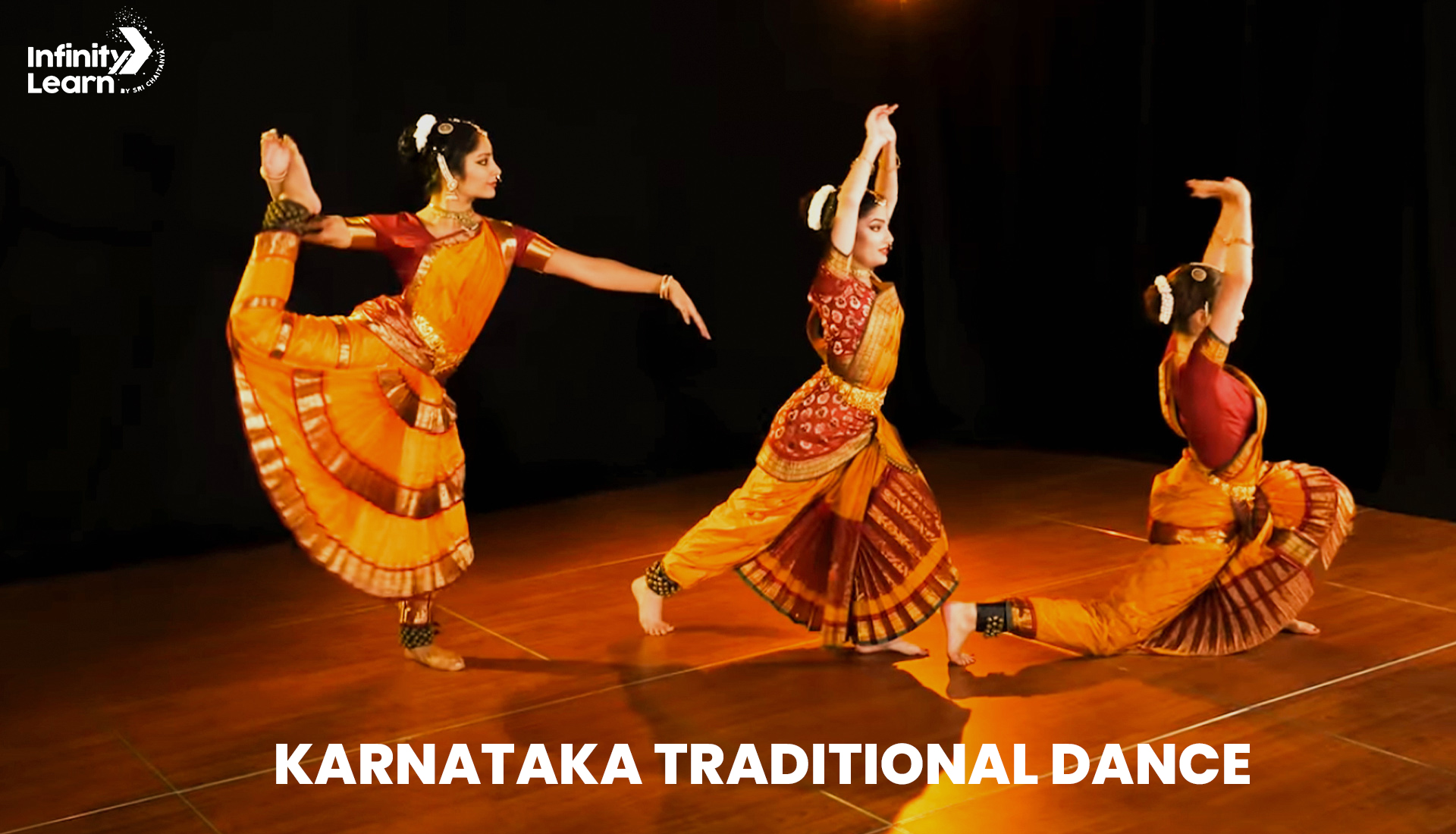
What is Karnataka Traditional Dance?
Karnataka traditional dance is an integral part of the state’s cultural heritage. These dances are a harmonious blend of rhythm, storytelling, and expression, often accompanied by traditional music and colorful costumes. Each dance form has its unique style, significance, and history, making it a captivating reflection of Karnataka’s culture.
7 Popular Forms of Karnataka Traditional Dance
Karnataka has a treasure trove of traditional dances that have enchanted generations. These traditional dances are not just performances; they are a window into Karnataka’s rich heritage. Let us unravel the captivating world of Karnataka traditional dance, exploring what it is and delving into seven popular forms that continue to enthrall audiences today.
1. Yakshagana: Yakshagana is a prominent traditional dance drama of Karnataka. It combines dance, music, elaborate costumes, and makeup to depict mythological and historical stories. Yakshagana performers, known as “Yakshagaru,” use dramatic storytelling techniques and energetic dance moves to captivate the audience.
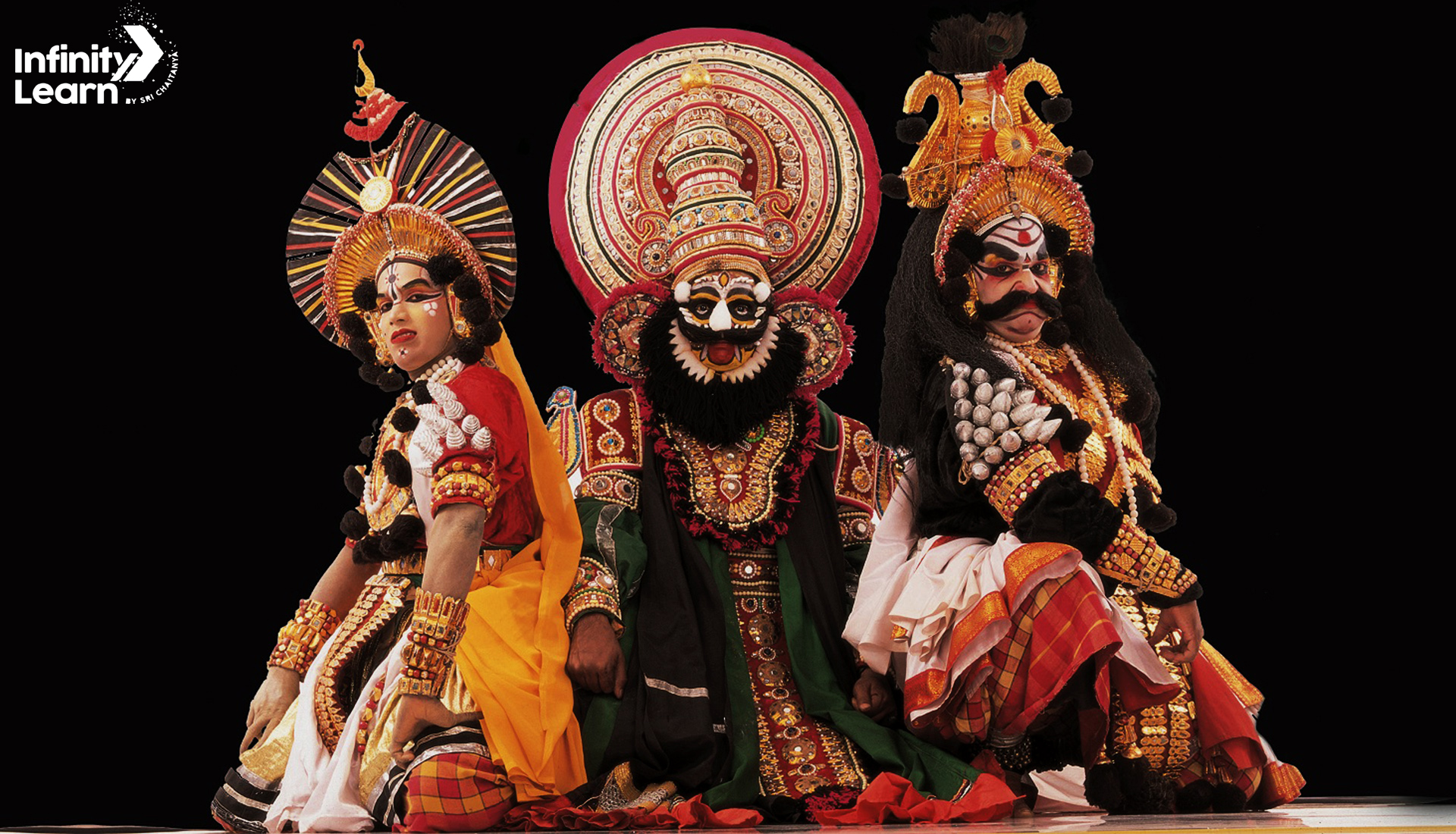
Key Features of Yakshagana
- Mythological and Historical Themes: Yakshagana performances primarily revolve around mythological and historical stories. These stories are often derived from Hindu epics like the Mahabharata, Ramayana, and Puranas.
- Vibrant Costumes and Makeup: Yakshagana is known for its elaborate and colorful costumes. The performers, both male and female, wear intricately designed attire that includes headgear, masks, and accessories. The makeup, which involves bold and expressive facial paint, is a striking feature of Yakshagana.
- Music and Instruments: Traditional Yakshagana music plays a crucial role in the performances. The musical ensemble typically includes percussion instruments like the chande (drum), maddale (double-headed drum), and harmonium. Musicians accompany the dancers and vocalize the narrative through song.
- Dynamic Dance Moves: Yakshagana is characterized by energetic and dynamic dance movements. Performers often execute intricate footwork, swift spins, and dramatic gestures to convey the storyline. The dance is physically demanding and requires a high level of skill and endurance.
- Narration and Storytelling: Yakshagana performances are not merely dances but intricate forms of storytelling. The performers narrate the story through song and dialogue, bringing the characters to life with their expressions and movements. The dialogues are delivered in the regional language, Kannada.
- Spiritual and Cultural Significance: Yakshagana is not limited to entertainment; it holds deep spiritual and cultural significance. It is often performed during religious and cultural festivals in Karnataka, adding to the spiritual aura of the events.
- Variations: Yakshagana has two main regional variations: Badagutittu (Northern style) and Tenkutittu (Southern style). Each style has its unique characteristics and repertoire of stories.
2. Dollu Kunitha: Dollu Kunitha is a vibrant and energetic folk dance of Karnataka, typically performed during festivals and celebrations. Dancers use traditional drums called “dollu” to create rhythmic beats while executing intricate dance steps. The dance is characterized by its joyful and communal spirit.
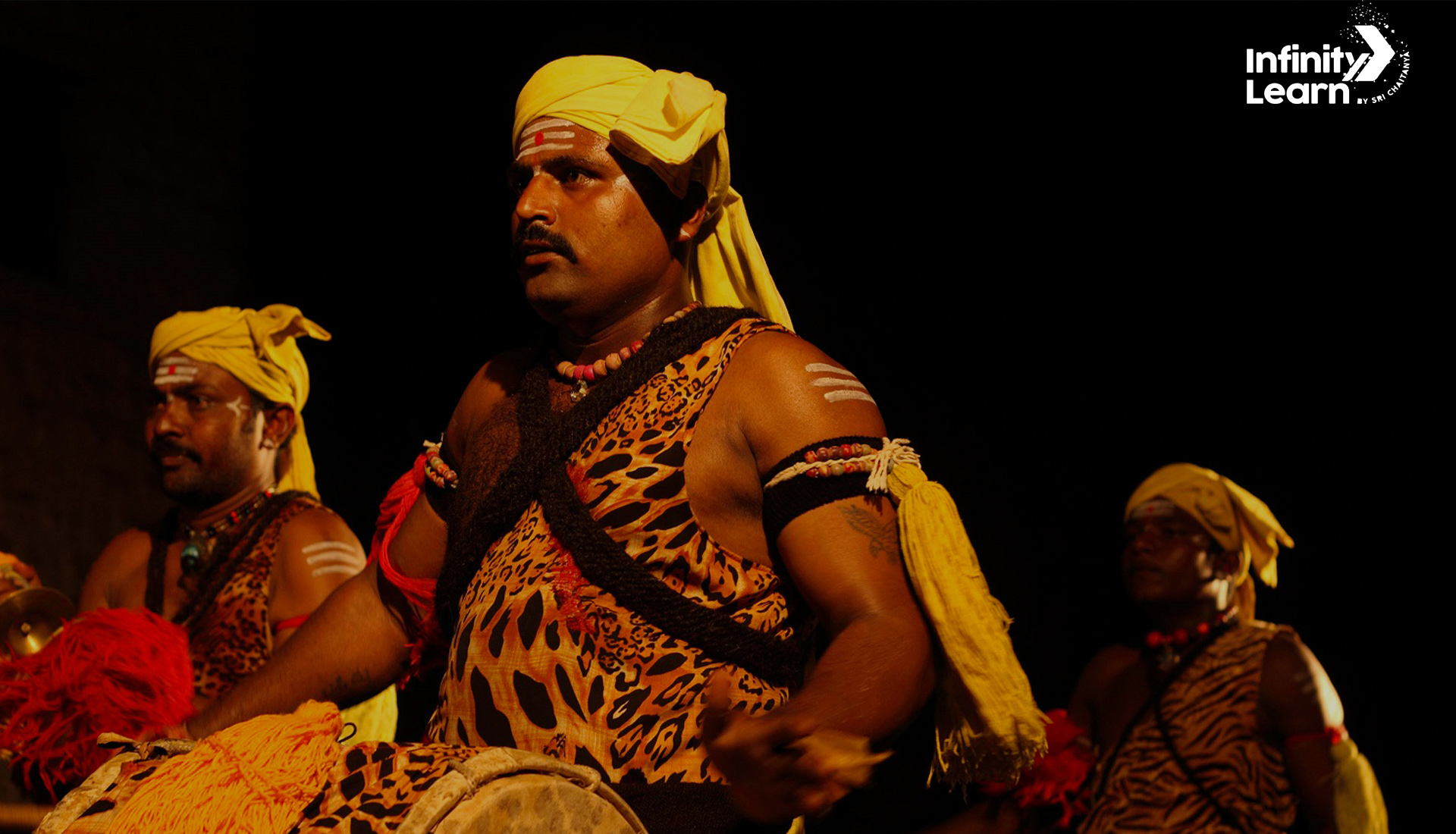
Here are the key features of Dollu Kunitha
- Rhythmic Drumming: Dollu Kunitha is known for its energetic drumming. Performers use large traditional drums called “dollu” to create rhythmic beats. The drumming is central to the dance and sets the pace for the entire performance.
- Group Dance: Dollu Kunitha is a group dance, with multiple dancers participating in the performance. The dancers move in synchronized formations, creating visually appealing patterns and rhythms.
- Colorful Attire: Dancers wear colorful and traditional attire, which often includes brightly colored dhotis (lower garments), turbans, and embellished waistbands. The costumes add to the visual vibrancy of the performance.
- Jingling Anklets: Dancers adorn their ankles with jingling anklets, adding a musical element to their movements. The sound of these anklets complements the drumming and enhances the overall auditory experience.
- Energetic Movements: Dollu Kunitha involves dynamic and vigorous movements. Dancers perform fast footwork, jumps, spins, and expressive hand gestures. The dance exudes an enthusiastic and joyful energy.
- Narrative Themes: While the primary focus is on the dance and drumming, Dollu Kunitha often tells stories from folklore, mythology, and rural life. These narratives are conveyed through dance and gestures, adding a storytelling element to the performance.
- Community Participation: Dollu Kunitha is often performed by community groups and local troupes. It brings together people of various ages and backgrounds, fostering a sense of community and unity.
- Festive Occasions: The dance is typically performed during festivals, fairs, and celebrations, especially in rural areas of Karnataka. It is an integral part of cultural and religious events.
- Celebratory and Communal: Dollu Kunitha is a celebratory dance that adds to the festive atmosphere of the occasions it is performed at. It is also a communal activity that brings people together to celebrate and express their cultural heritage.
- Cultural Preservation: Dollu Kunitha plays a vital role in preserving and promoting Karnataka’s cultural traditions. It showcases the state’s rich and diverse folk heritage.
3. Bhootha Aradhane: Bhootha Aradhane is a unique traditional dance in Karnataka that pays homage to village deities or “Bhoothas.” Dancers wear elaborate masks and costumes representing these deities and perform to the rhythmic beats of drums. The dance is an integral part of religious and cultural festivals in Karnataka.
| Other Topics of Indian Culture | |
| What is Rich Cultural Heritage | Traditional Dress of Gujarat |
| List of all Festivals of India | Paragraph on Indian Culture |
| Speech on Indian Culture | Essay on Indian Heritage |
| Andhr Pradesh Traditional Dress | How Old is Culture in India |
| Traditional Dance of Maharashtra | Capital of Bihar |
| Traditional Dance of Andhra Pradesh | Malegaon – A Cultural and Historical Gem of Maharashtra |
| Capital of Punjab | Rajasthani Traditional Dress |
| Indian History, Culture, and Diversity | |
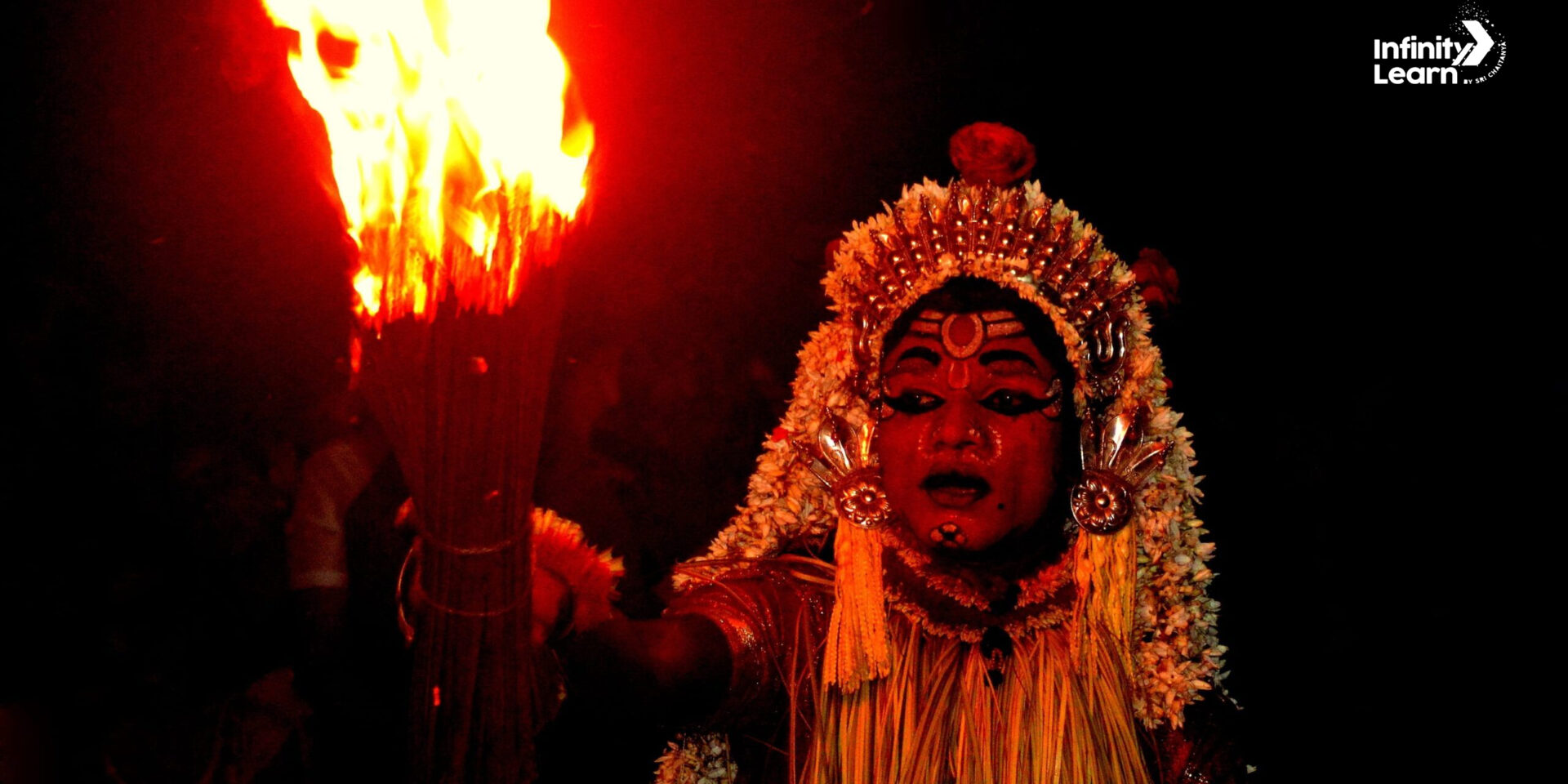
Here are the key features of Bhootha Aradhane
- Veneration of Deities: Bhootha Aradhane is a ritualistic dance form that is primarily performed to worship and pay homage to village deities, known as “Bhoothas.” These deities are believed to protect and bless the local community.
- Elaborate Costumes and Masks: Performers in Bhootha Aradhane wear elaborate costumes and masks that represent the Bhoothas. These masks are often intricate and visually striking, with colorful designs and symbolic features.
- Traditional Music and Instruments: The dance is accompanied by traditional music, which includes percussion instruments like drums, cymbals, and wind instruments. The music adds rhythm and atmosphere to the performance.
- Spiritual Significance: Bhootha Aradhane is deeply rooted in spirituality and devotion. It is performed during religious festivals and special occasions to seek the blessings and protection of the Bhoothas.
- Narrative Element: While Bhootha Aradhane is primarily a religious ritual, it often incorporates elements of storytelling. The dance may depict legends and mythological stories associated with the Bhoothas, enhancing the narrative aspect.
- Communal Participation: Bhootha Aradhane is a communal activity that involves the participation of local communities. It brings people together to celebrate their shared cultural and religious heritage.
- Processional Dance: In some instances, Bhootha Aradhane involves processional dances where the deity is taken in a procession through the village or temple premises. This allows the community to interact with the deity and seek blessings.
- Traditional Rituals: The performance of Bhootha Aradhane is often accompanied by traditional rituals and offerings, including flowers, incense, and food offerings to the Bhoothas.
- Protection and Blessings: The primary purpose of Bhootha Aradhane is to seek the protection and blessings of the Bhoothas for the well-being and prosperity of the community. It is believed that these deities play a crucial role in safeguarding the village.
- Cultural Heritage: Bhootha Aradhane is a vital part of Karnataka’s cultural heritage. It reflects the state’s deep-rooted traditions, religious beliefs, and the importance of community bonds.
4. Kamsale Dance: Kamsale dance is a traditional folk dance form that originates from the southern Indian state of Karnataka, particularly from the Malnad region. It is known for its unique combination of rhythmic movements and percussive music.
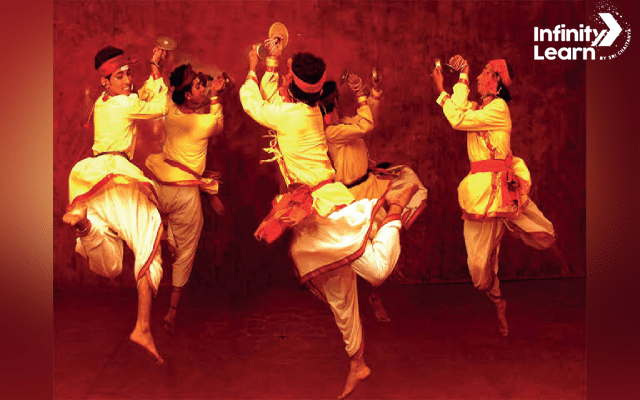
Here are the key features of Kamsale Dance
- Use of Cymbals (Kamsale): Kamsale Dance derives its name from the primary musical instrument used, known as “Kamsale.” The Kamsale is a pair of brass cymbals attached to a wooden frame. Dancers hold these cymbals in their hands while performing, creating rhythmic beats.
- Rhythmic Footwork: Kamsale Dance involves intricate and rhythmic footwork that complements the music produced by the Kamsale. Dancers create complex rhythms and patterns with their feet, enhancing the auditory and visual aspects of the performance.
- Narrative Themes: Like many traditional dance forms, Kamsale Dance often tells stories from Hindu mythology, folklore, and rural life. The dancers use expressive movements and gestures to convey the narrative.
- Solo and Group Performances: Kamsale Dance can be performed both as solo acts and in group formations. Solo performances allow individual dancers to showcase their skills, while group performances create a collective and vibrant display.
- Colorful Attire: Dancers wear colorful and traditional attire, often consisting of turbans, dhotis, and decorative garments. The costumes add to the visual appeal of the performance.
- Narration Through Song: Kamsale performances often include songs that narrate the story being depicted. The dancers may also sing while dancing, adding a vocal dimension to the art form.
- Spiritual and Cultural Significance: Kamsale Dance is often performed during religious and cultural festivals in Karnataka. It is considered a form of devotion and a means of connecting with the divine.
- Training and Tradition: Learning Kamsale Dance involves rigorous training under experienced instructors. The tradition is passed down through generations, emphasizing the importance of preserving this cultural heritage.
- Community Participation: Kamsale Dance is a communal activity that brings people together during festivals and celebrations. It fosters a sense of community and cultural identity.
- Celebratory and Festive: The dance is celebratory in nature and adds to the festive atmosphere of the occasions it is performed at. It is an expression of joy and cultural pride.
5. Karaga Dance: The Karaga festival in Karnataka features a dance known as the Karaga Dance. During this festival, a male performer, dressed as a woman, balances a large and ornate Karaga (a sacred pot) on his head while dancing through the streets. The Karaga Dance symbolizes the goddess Draupadi and is a significant cultural and religious event in Karnataka.
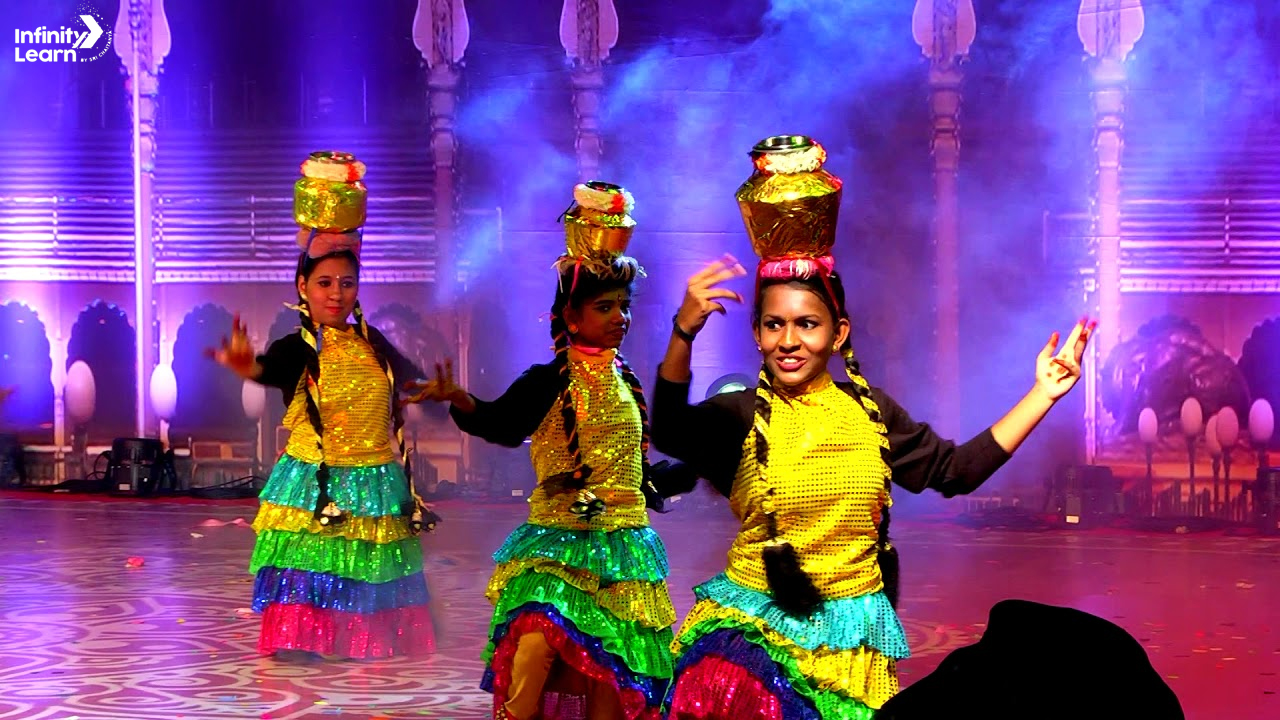
Here are the key features of Karaga Dance
- Sole Female Performer: Karaga Dance is traditionally performed by a male dancer, who is dressed as a woman. The performer is known as the “Veera Kumar” or “Draupadi,” and they take on the role of the goddess Draupadi from the Mahabharata epic.
- Balancing a Pot (Karaga): The central element of the Karaga Dance is the “Karaga,” a large, ornate pot made of brass or copper. The pot is filled with water and decorated with flowers and coconut leaves. The dancer skillfully balances this heavy pot on their head throughout the performance.
- Elaborate Costume: The Veera Kumar adorns a traditional and elaborate costume, which includes a saree, jewelry, and decorative headgear. The costume symbolizes the goddess Draupadi’s appearance.
- Processional Dance: Karaga Dance is a processional dance that takes place during the Karaga festival. The dancer leads a grand procession through the streets of Bangalore, carrying the Karaga on their head. The procession is a significant part of the festival.
- Spiritual Significance: The Karaga festival is deeply rooted in Hindu mythology and is dedicated to the goddess Draupadi. It is believed that Draupadi’s spirit possesses the Veera Kumar during the dance, and the dance symbolizes her journey.
- Music and Chants: The dance is accompanied by traditional music and chants that create an ambiance of spirituality and devotion. Drummers and musicians play traditional instruments to accompany the performance.
- Symbol of Strength: The Veera Kumar represents strength and valor. Balancing the heavy Karaga pot on the head symbolizes the power and resilience of Draupadi and is seen as an act of devotion and penance.
- Community Participation: The Karaga festival and dance involve the participation of the local community. It is a communal event that brings people together to celebrate their shared culture and faith.
- No Breaks: The Veera Kumar performs the Karaga Dance without taking a break. The dance continues throughout the night as part of the overnight procession.
- Fasting and Penance: Before performing the Karaga Dance, the Veera Kumar observes fasting and purification rituals to prepare for the sacred act.
6. Bolak-aat (Bolak Dance): Bolak-aat, also known as Bolak Dance, is a traditional folk dance form that originates from the northern Indian state of Himachal Pradesh. It is known for its lively and energetic style, often performed during festivals and celebrations.
Here are the key features of Bolak-aat
- Community Dance: Bolak-aat is a group dance performed by the local community, with both men and women participating. It is a communal activity that brings people together to celebrate and express their cultural identity.
- Colorful Attire: Dancers wear colorful traditional attire that includes vibrant costumes, headgear, and accessories. The costumes add to the visual vibrancy of the performance.
- Fast and Energetic Movements: Bolak-aat is characterized by fast and energetic dance movements. Dancers execute quick footwork, jumps, spins, and rhythmic patterns, creating an exhilarating performance.
- Live Music: The dance is accompanied by live music, usually performed with traditional instruments such as the dhol (drum), nagara (kettle drum), and shehnai (wind instrument). The music sets the rhythm and pace of the dance.
- Narrative Themes: Bolak-aat often portrays stories from local folklore, mythology, and rural life. The dance serves as a means of storytelling and cultural expression, conveying narratives through movement and expressions.
- Rhythmic Clapping and Chanting: Dancers often engage in rhythmic clapping and chanting during the performance. This adds to the overall rhythmic and percussive nature of the dance.
- Celebratory Occasions: Bolak-aat is typically performed during festive occasions, religious festivals, and special events. It contributes to the festive atmosphere and cultural celebrations.
- Community Bonding: The dance fosters a sense of community and cultural bonding. It is an opportunity for people to come together, celebrate their shared heritage, and strengthen social connections.
- Cultural Preservation: Bolak-aat plays a vital role in preserving and promoting the cultural traditions of Himachal Pradesh. It showcases the state’s rich and diverse folk heritage.
- Spiritual and Cultural Significance: Bolak-aat often carries spiritual and cultural significance, especially when performed as part of religious ceremonies or rituals. It is seen as a form of devotion and a means of connecting with the divine.
- Audience Participation: Bolak-aat performances often encourage audience participation, with spectators clapping or joining in the dance, further enhancing the festive and communal spirit.
7. Veergase: Veeragase is a traditional folk dance form that originates from the southern Indian state of Karnataka, particularly in the region of North Karnataka. It is known for its energetic and vibrant performances, often centered around themes of valor and mythology.
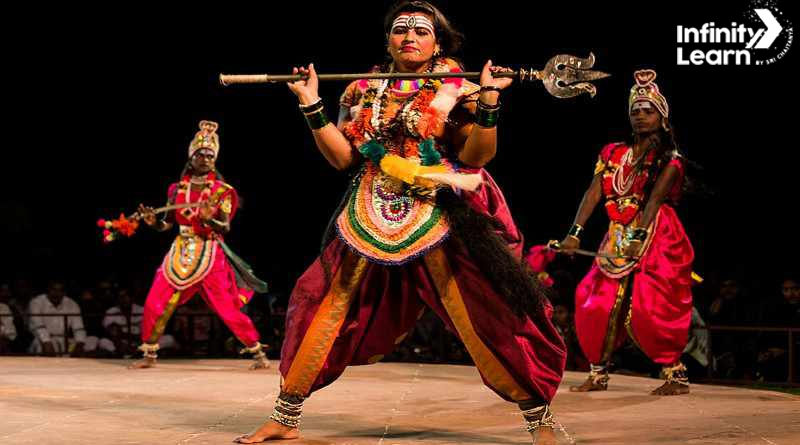
Here are the key features of Veeragase
- Solo and Group Dance: Veeragase can be performed both as a solo dance and in group formations. Solo performances allow individual dancers to showcase their skills, while group performances create a collective and dynamic display.
- Mythological Themes: Veeragase typically portrays stories from Hindu mythology and epics, including episodes from the Ramayana and the Mahabharata. Dancers depict characters and events from these narratives through their movements.
- Colorful Attire: Dancers wear colorful and traditional costumes that often include dhotis (lower garments), turbans, and embellished waistbands. The costumes are adorned with decorative elements that enhance the visual appeal of the performance.
- Body Paint: In some variations of Veeragase, dancers paint their bodies with colorful patterns and designs, adding to the overall visual aesthetics of the dance.
- Expression and Gestures: Veeragase incorporates a wide range of facial expressions and hand gestures, known as “mudras,” to convey emotions, characters, and storytelling elements. These expressions play a crucial role in the performance.
- Energetic Movements: The dance is characterized by vigorous and energetic movements. Dancers execute lively footwork, jumps, spins, and rhythmic patterns, creating an exciting and captivating performance.
- Traditional Music: Veeragase is accompanied by traditional music, typically featuring percussion instruments like the dhol (drum), chande (drum), and maddale (double-headed drum). The music complements the dance and sets the rhythm.
- Narration Through Song: The dance is often narrated through songs sung by the dancers themselves or by accompanying musicians. These songs provide context and explanation for the stories being depicted.
- Spiritual Significance: Veeragase is often performed during religious festivals and rituals in Karnataka. It is considered a form of devotion and a means of connecting with the divine.
- Community Participation: Veeragase is a communal activity that brings people together during festivals and celebrations. It fosters a sense of community and cultural identity.
- Celebratory Nature: The dance is celebratory in nature and contributes to the festive atmosphere of the occasions it is performed at. It is an expression of joy, cultural pride, and devotion.
- Preservation of Tradition: Veeragase plays a vital role in preserving and promoting Karnataka’s cultural traditions. It showcases the state’s rich and diverse folk heritage.
These seven traditional dance forms are just a glimpse of the cultural richness that Karnataka offers. Each dance form has its distinctive charm and significance, and they continue to be an integral part of Karnataka’s cultural identity. Whether you’re witnessing the grandeur of Yakshagana or the grace of Bharatanatyam, Karnataka’s traditional dances are a testament to the state’s vibrant heritage and artistic excellence.
Karnataka Traditional Dance – FAQ’s
What is the folk dance drama of Karnataka?
The folk dance drama of Karnataka is Yakshagana, known for its vibrant enactment of mythological stories through music, dance, and elaborate costumes.
What is the traditional art form of Karnataka?
One of the traditional art forms of Karnataka is Yakshagana, a captivating dance drama that blends elements of dance, music, and storytelling.
What is Karnataka's famous dance?
Karnataka is renowned for Yakshagana, a vibrant and colorful dance drama that's an integral part of the state's cultural heritage.
What is the folk dance of Karnataka, Yakshagana?
Yes, Yakshagana is a popular folk dance drama in Karnataka, known for its lively performances depicting mythological tales.
Which are the classical dances?
Classical dances in Karnataka include Bharatanatyam, Kathak, Kuchipudi, Odissi, Mohiniyattam, and more, each with its unique style and origins.
What is the importance of Yakshagana dance?
Yakshagana holds cultural significance as it preserves and showcases Karnataka's folklore, traditions, and mythological tales through vibrant performances, music, and storytelling.







